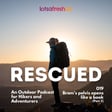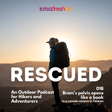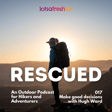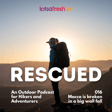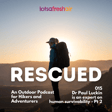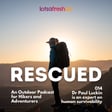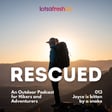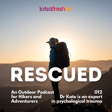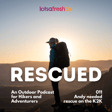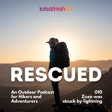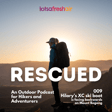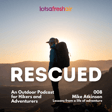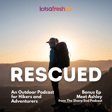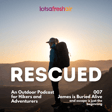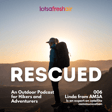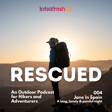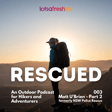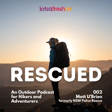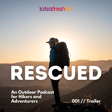Become a Creator today!Start creating today - Share your story with the world!
Start for free
00:00:00
00:00:01

005 // Owen & the Australian Alps Walking Track
We all know the importance of having solid first aid skills when we head off into the bush. A good remote area first aid course not only gives us the technical know-how of what to do in an emergency, but confidence to step in and act when someone suffers an injury.
However, there’s something that first aid courses can’t really prepare us for that can leave us feeling vulnerable especially when travelling solo.
In this episode, I hear from experienced bushwalker, cross-country skier, runner and all round adventure traveller, Owen, on what happened during day 24 of the 650 km Australian Alps Walking trail when he found himself alone and pushing the SOS button.
Episode takeaways:
- The value of good planning
- To consider how to deal with medical emergencies in the bush, not just obvious first aid
- Being aware of the limitations of solo walking - not able to share the load of decision making and actions
- Value of testing and checking charge on satellite comms
- Making well thought out decisions in the middle of crisis
- Value of satellite comms and the SOS button
- Importance of finding closure after an incident
Transcript
Introduction to Rescue Experiences
00:00:00
Speaker
Rescued is a podcast of conversations with rescuers and those who've been rescued. It's about the lessons we learn about ourselves, the places we go and why, without judgement, to help us have better adventures, manage risk and deal with the unexpected.
00:00:19
Speaker
We all know the importance of having solid first aid skills when we head off into the bush. A good remote area first aid course not only gives us the technical know-how of what to do in an emergency, but a big part of it is giving us the confidence to step in and act when someone suffers an injury.
00:00:38
Speaker
However, there's something that first aid courses can't really prepare us for that can leave us feeling vulnerable, especially when travelling solo.
Owen's Adventures in the Australian Alps
00:00:46
Speaker
In this episode, I hear from experienced bushwalker, cross-country skier, runner and all-round adventure traveller Owen on what happened on day 24 of the 650 kilometre Australian Alps walking trail, when he found himself alone and pushing the SOS button.
00:01:04
Speaker
Tell me a little bit about your earliest memories of time in the bush and specifically the Australian Alps. My interest in the Alps started back in the primary school days. I suppose the very first trip was I was asked to go skiing with a schoolmate from primary school and they took me up to Mount Buller for the day. Up until then all our holidays had been sort of like beach holidays as a family.
00:01:27
Speaker
And to go to the mountains was just something totally foreign to me. So it was pretty special and it was weird weather. It started off nice in the morning and then it fogged in. And that was the most beautiful part of the day was when the fog rolled in and the snow gums were just disappearing in and out of the fog.
00:01:44
Speaker
and I'd never skied before but I managed to ski a little bit down this slope and I pulled up when the fog rolled across and out of these ski villages they have like music playing over the sound system.
The Beauty of Snowy Landscapes
00:01:57
Speaker
I first heard this song Sounds of Silence by Simon and Garfunkel and it was just such a fitting moment to hear that song for the first time and to be sort of standing on the side of this mountain with the fog rolling across and just the silhouettes of the snow gums disappearing in and out of the fog was
00:02:14
Speaker
just something I've never experienced and it's stayed with me ever since. I mean, it's interesting you say the sounds of silence because that's something that's always struck me of when there's snow on the ground, unless there's a strong wind up in those alpine areas. Yeah, exactly. Just the quietness. Indeed.
Art and Nature Appreciation
00:02:31
Speaker
Can you remember how you felt as a young child, what you were thinking at the time and feeling?
00:02:36
Speaker
I didn't feel frightened by it at all even though it was something totally I'd never sort of experienced but I suppose I'd seen for me mornings in Melbourne and things like that where we grew up it was just just so beautiful and that was the thing that struck me I think it was just that I was away from my friends at that moment and just on my own and just
00:02:54
Speaker
just marbling at the beauty of the mountains and snow guns. Yeah, those sort of twisted trunks and branches that are leaning away from the wind and it's just something that I've never seen anything like it. And describe what happens when the gum gets wet. Yeah, well it gets wet and it just gets a sheen to it. The colours really become more intense when it's wet, the pinks.
00:03:21
Speaker
greens and olive green are greys and things like that. They just take on a different characteristic when they're wet.
Adventurous Pursuits Beyond Borders
00:03:28
Speaker
Talk to me about painting and how that comes with you when you go to the bush. Is being a painter and an artist and seeing colors like that, does that influence your time in the bush, do you think?
00:03:41
Speaker
Oh, definitely. Yeah, painting and my hiking really go hand in hand. I'm always looking at the landscape. I developed an interest in art in the year 11 and 12 at high school, and that's much sort of formal training that I had in painting.
00:03:59
Speaker
I don't know, when I wander around, I'm looking at colours, I'm looking at the way the ridge lines sort of fall away. They start up above the tree line, you see them sort of disappear down into the mountain ash and alpine ash. And just sort of bit by bit, collect up like a little collection of images in your mind and it's just nice to draw and paint and wrestle with it a bit. It's a challenge, it's a bit of a happy challenge that I really like. Do you take photos as well or do you focus more on painting?
00:04:28
Speaker
These days I take less and less photos, I just take them for the sake of a painting to try and remember something so I don't forget them. But coming back to your time in the bush and to your experience, so we talked about the primary school and that first engagement with the Alps,
00:04:45
Speaker
How did that develop into what appears to be a really long and really full adventurous life that you've led? The next time, it was a bit of an interval from there. It wasn't towards the end of high school that we had another skiing event where a group of us from high school and we'd finished the following winter. We went up to Falls Creek this time and we were staying in a lodge there and downhill skiing during the day.
00:05:13
Speaker
And it just so happened that by pure coincidence, one of our teachers from high school, he ended up staying in the same lodge we were at. And I noticed one morning, he was heading off with his really strange looking skinny skis and I started to ask him, you know, what have you got there? And he said, they're cross country skis, Norwegian cross country skis or something, Swedish skis or something like that. And I explained how it worked and told me that you stick different waxes on the bottom and you can climb up yours with them. And I was fascinated by this and I said,
00:05:43
Speaker
I wonder if you can hire them. I'd love to come out with you, but one shop had a handful of cross-country skis, and I got lucky. So we headed off from Falls Creek. We went up across Rocky Valley Dam, which is sort of just outside of the resort area, and up a spur called Heathy Spare, and up towards Mount Nels, which is I think the third highest mountain in Victoria.
The Australian Alps Walking Track (AAWT)
00:06:06
Speaker
It was a beautiful pristine day, not a breath of wind.
00:06:10
Speaker
You can see the snowing mountains way off in the distance. It was just magical and quiet and no crowds. That was the last time I ever went downhill skiing. I took up cross-country skiing and really got into bushwalking in a big way after that. It made me to look at where you could go skiing during the winter months.
00:06:29
Speaker
It's sounding like you're hooked on this Alpine environment for Victorian and the Australian Alps. It wasn't just in Australia. You've had off-track and quite interesting expedition type experience, not just in Australia. Is that correct? In the 80s, we spent a bit of time traveling through Nepal and India. In 1984, that would have been.
00:06:56
Speaker
a six-month trip which was self-guided. Me and my partner headed off to Nepal and we were told we should get a guide to take us around the Annapurnas and we managed to find a guide and his friend was going to be a portrait carry gear for us and we went around the Annapurna circuit which was a really nice trip.
00:07:19
Speaker
We had a lovely time before us. We shared our planning and leading experiences with them. By the end of the trip, I reckon they were pretty good guys. Back in the 80s, that would have been so different, too, than I think of today.
00:07:35
Speaker
We went back to the Everest region and couldn't believe how much the population was really squeezing and a lot more cars. It was a very, very different place. It all changes quickly. To fill in a bit of background there from those first early experiences in the Alps, you've also then had years and years of experience in the mountains and bushwalking. Can you just tell me a little bit
Challenges on the AAWT: Planning and Obstacles
00:08:01
Speaker
about, just broadly about that?
00:08:02
Speaker
Yeah, yeah, look, I think bushwalking's always been the anchor. Even though cross-country skiing was probably what really sows the seed for me, but I really, I like the simplicity of bushwalking. It's really minimalist and you can really scale it back. You don't have to take a lot of gear, you just take what you need to take to be safe and be self-reliant. I think that's what people really need to understand with bushwalking to be
00:08:27
Speaker
be safe and be self-reliant and you can have a wonderful time. There's no doubt about it. Tell me when you first became aware of what's now called the AAWT, or the Australian Arts Walking Track. Tell me what that is. Explain to people what the AAWT is. It starts in Wellhallah.
00:08:48
Speaker
Yeah, it's quite low. It's right down near the Thompson River in a small old gold mining town. That's where Haller is, the gold mining town. And it follows these old railway lines where they used to bring timber and things like that to make mine shafts and things like that. Lots of little networks of sort of benched train tracks running across the hillside. So it follows those along to the Thompson River. You eventually cross the Thompson River, then you start climbing up through
00:09:18
Speaker
Mount Anish towards Mount Bulbul, which is a central subalpine plateau, a very beautiful plateau, because it hasn't been burnt since the 1939 fire, so it's a wonderful, very pretty subalpine environment that runs for about 20 k's from one end to the other. Yeah, that's a nice introduction to the Alps is when you walk across the Bulbul plateau.
00:09:44
Speaker
And so, from that time, the AAWT has sort of now become longer and bigger than that. Yes, that's right. Now it's called the Australian Alps walking track. It pretty much follows much the same route as the original Victorian part of it, except before you start to head up to Tom Groban, you end up
00:10:05
Speaker
starting to head more northeast from the Bananbracory on the road and it takes you across towards the Cobras and up into New South Wales you go past the pilot and come out near Threadbale with a place called Dead Horse Gap and you start to climb up onto the main range from there, the Snowy Mountains main range. Now the full length of the AAWT, how long is that?
00:10:27
Speaker
It's about 660 kilometers from Valhalla to Tharwa in the ACT. Amazing. And how long does that normally take people to do? I think the quickest time that it's been done was just under 11 days from start to finish. Oh my goodness. These two people. The interesting thing is they tried it twice. The first time they tried to run it and they fell apart physically. The second time they attempted it, I think they worked out
00:10:54
Speaker
How how long could they walk each day? And I think they worked out they could walk about 18 hours a day and they would have about six hours rest a couple of hours in the middle of it and four hours at the end of it and get up and off they go again.
00:11:08
Speaker
And so tell me about when you decided to give it a red-hot go and what was happening at the time for you. Yeah, well, just before COVID, I started to come up with an asshole to myself. I should try and do the new sections that I hadn't done. So the sections in the New South Wales and into the ACT.
00:11:28
Speaker
And I started planning that and then there was a 2019, 2020 bushfire season. So that sort of put a stop to that. And then just as the tracks were starting to be opened up again, along came COVID and that sort of shut me down again for a couple
Support and Preparation for Treks
00:11:45
Speaker
more years. And I eventually got to have a go at it in 2022. And it all went beautifully well until I ran into troubles on the long spur coming off Mount Bogon.
00:11:58
Speaker
Massive thanks for the support from the team at Patti Pallon, who since 1930 have been leaders in travel and outdoor adventure. In fact, did you know that Patti himself, a member of the Sydney Bushwalkers Club, was a volunteer in the original Search and Rescue Arm of the Federation of Bushwalking Clubs in New South Wales? Hmm, nice one Patti.
00:12:18
Speaker
Let's wind it back and talk about your preparation. Preparation was very detailed because that was lots of time over COVID. I've got this amazing spreadsheet of about 10 different tabs from everything from distances to food, to where are we going to put food drops in, to
00:12:37
Speaker
you know, how much my pack would weigh in on just about any sort of section of the track after picking up food drops. So it was a lot of plenty of time to do this amazing detailed plan on how I was going to pull this all together. And what about preparing your body? Had you kept your fitness up during coding?
00:12:55
Speaker
Yeah, another thing I do, I do a lot of running. That's another sort of passion of mine is sort of running half marathons and occasionally a marathon. But that all came about from bush walking. It was an efficient way to keep fit for walking was to go running during the week.
00:13:14
Speaker
I've always kept up my running as well as my walking. I was pretty fit. Always feels a bit different the first couple of days, but after three or four days, your feet really settle into your boots. You feel great. That's good. Okay. So 27 days in, were you? About 21 days. I think it was 21 on that day that I, where things went a bit pear-shaped. Tell me what happened.
00:13:42
Speaker
Well, about 24 hours before I was going across the bogon, just finishing the section across the bogon high plains and going up over Mount Nelson down towards Ropers Hut, which is on the northern end of the bogon high plains. And I was, yeah, I camped at Ropers Hut and then the next day I headed off towards Mount Bogon and the weather was changing.
00:14:02
Speaker
It became a really toxic night up on Mount Bovon near Cleve Coal Hut. There was a roaring sort of front coming through and my poor little tent held up, but I looked out the door a couple of times. You could see the tent pigs wobbling around as they're coming off. I thought, gee, if one of them comes out, I'll end up back where I started. But it held out, I think I got about.
00:14:24
Speaker
one or two hours sleep and the next morning I got up and had a look around and thought, gee, what should I do? Should I just sit out the weather at Cleve Coal Hut for another 24 hours or should I plug on to Mount Wills, which was my next food shop and there was also a hut there. And I thought, well, I'm going to start descending to a lower sort of altitude from here on. It will get lower till I get up onto Mount Wills. And so I chose to plug on towards Mount Wills and
00:14:53
Speaker
so I put on all my wet weather gear and it was quite comfortable and warm and packed up wet tent and got underway and that all was going okay. I was plodding along for about an hour an hour and a half or so up over down Camp Valley then up over Hill called Bosea Hill and I hit the long spur which was nicely cleared a week before the volunteer group from Bushwalking Victoria called Bush and Track Conservation Group. It cleared the long spur which was
00:15:23
Speaker
That was wonderful. How good are the volunteers? Yeah, they are. I'm actually a member of that group, so I didn't quite involve them. I knew that we were going to clear that track, which I was looking forward to it. And I was probably about a half an hour along the long spur, and I felt a bit of a twinge in my right lower back.
00:15:43
Speaker
probably just something from a bad night's sleep, you know, uncomfortable cold and what have you. But within about half an hour it changed to an excruciating pain in my right
Handling Health Emergencies on the Trail
00:15:54
Speaker
kidney area. There were just like waves of hot and cold fever rushing through my body. The pain was like
00:16:01
Speaker
horrendous. I was just shaking and vomiting and really rapidly into a shocking state and really at first wasn't sure what to do. It just took a while to think about do I turn back or do I go ahead and I figured to go back was just walking back into freezing cold windy weather and I thought it was probably going to be easier going downhill on the
00:16:27
Speaker
on the clear track and luckily in part of my planning I'd go on to see my GP and he'd prescribe some fairly heavy duty painkillers for me in the event that I like twist my ankle or break an arm or something like that so I had some fairly heavy dose pain relief and to be upfront on it I had had kidney stones about 30 years before and I spoke to the GP about this and
00:16:55
Speaker
He said, well, if you haven't had them for so long and you're really well and truly past that sort of age group where males tend to get them, they tend to get them around the mid 30s to mid 50s and then they're not so common after that sort of age bracket.
00:17:11
Speaker
So you can't spend your life wrapped up in cotton wool and go to keep walking on this. So true. Yeah. I mean, is there anything you can do for kidney stones? Is there any sort of first aid treatment you can give? No, really pain relief is all they can really do. Initially, when I got them 30 years ago, they
00:17:33
Speaker
Did some tests and back then they had ideas that you could have modified your diet. They took certain things out of my diet and I've been fairly religious about those. Things like certain greens like asparagus, spinach, fermented dairy products, oily fish, things like that.
00:17:51
Speaker
I've been following that, but when I spoke to the GP on coming back, he said, well, you probably didn't need to. He said, oh, that's sort of been debunked now. It's mainly just about hydration. The best preventative thing is just not so much diet. It's more about just keeping up your hydration in your daily life.
00:18:10
Speaker
Because the thing that strikes me and what is unique about something like kidney stones, or I guess it's anything medical that happens in the bush. If you have an injury, like you twist your ankle, like you're saying, or you break your arm, something like that, you can see what's wrong and you can apply first aid if you know how to do that. But when there's something happening internally, there's something happening medically with you,
00:18:37
Speaker
you know we're pretty complex beings there's a lot that could go wrong like there's so little that we can actually do about it yeah that's right so that's the risk element i suppose and you just need to prepare as best as you can some people have said oh maybe you shouldn't walk on on your own but i
00:18:52
Speaker
I do a bit of a mix of walking with clubs and with solo walking and I don't think that the outcome wouldn't have been any different. I was able to manage the situation and the same scenario would have happened if there was somebody with me. They would have, at some point, had to set off a PLB, which I could do anyhow. But it could have been a lot worse, I suppose. But that's the risk, I suppose.
Rescue Operations and Reflections
00:19:16
Speaker
It is. I guess that's just about knowing what those risks are, knowing what your own personal risk tolerance is, and then how you mitigate, how you lower risks where possible. Take me back to you taking the painkillers. I think that's where we got to. What happened next?
00:19:34
Speaker
Yeah, I was probably a couple of hours into the day I took the painkiller. And that was amazing. Wow, just knocked the edge off it straight away. I thought, this is pretty good. Magic. And I thought, well, what I should do, because it's not going to last forever, this painkiller, and this is going to come back and bite me again. So at that point, I really made a decision. I should try and get off the foot track and get down to at least the four-wheel drive track, which
00:20:04
Speaker
was a few kilometres on and even better still to get to Big River Saddle because if I can get there it's a clear area and I can put up a tent and shelter and really work out what to do. So that was my decision to plug on. I went on and
00:20:22
Speaker
About an hour later, sure enough, the painkiller started to wear off and the pain came back like a hammer. Just same thing again, just the waves of pain, the hot and cold sort of sweats, the vomiting coming back, the whole works was just the long. I thought, well, gee, I've only been an hour since I took, you know, you're only meant to take four of these things a day. I shouldn't be taking another one an hour later.
00:20:49
Speaker
So I thought I was just going to have to put up with it and I plugged on and at times it was that utter madness like I was really angry. I was angry with myself that I was in this situation and I was taking off my pack and swearing and kicking fractures and just really not in a good space at all. I plugged on for another hour and eventually got onto the four-wheel drive track which was a relief and
00:21:18
Speaker
I just sort of collapsed here on the side of the track when I got there and I was just still really toxic where there was sleet blowing through and wind and I thought, well, I'm going to take another painkiller now, at least I'm on the four-wheel drive track. I still really wanted to try and add it.
00:21:36
Speaker
somewhere in my mind that I needed to get to Big River Saddle. I probably could have set off the PLB there, but I just couldn't shelter. It was steep and wet and just messy. I couldn't wrap the tent around me or something. But I just didn't know. I had doubts about the PLB. It was a Garmin inReach. It's a US product. It's not sort of network to the Australian Emergency Rescue Service, which has a base in Canberra.
00:22:04
Speaker
And I started out with the painkillers or the pain, but started having all these wacky ideas that, you know, what happens if, you know, I set it off and the message goes to a base in Texas, and then they start to monitor there and work out what to do. And I thought, you know, what happens if it doesn't work or they go home at five o'clock or something like that? The time difference and things, that's just crazy sort of thoughts. But I thought, no,
00:22:33
Speaker
keep going to Big River Saddle. It's a bit close to the Omeo Metamita Highway if I wasn't able to be rescued there. Perhaps I could keep going and get through to the road. Yeah, and how fast do you reckon you were able to walk at this time? Like in such pain and with so much going on? Not very fast, yeah. Like 2km an hour tops kind of thing? Look, when it came to, like if there was a slight undulating rise in the Jeep track or something,
00:23:02
Speaker
I was just so weak. It might be from either the front gate or something, it'd be a little bit of a rise in it. I could barely get up, but it felt just shot, absolutely shattered. But I eventually got to Big River Saddle.
00:23:18
Speaker
put up my tent and I don't know I just felt well I think once I got to the four-wheel drive track I somehow got a bit of a lift mentally and thought I can get to Big River Saddle and I got there and I put my tent up as best as I could as quickly as it was and it's pretty kept the rain off me I'd say that's about about all and got inside I tried to change my clothes then I just noticed
00:23:42
Speaker
When I was trying to take the clothes off to put on the thermals, dry clothes and things, my body was just like, I couldn't undo buttons or drag on thermals. I was just like a shaking mess. Absolutely really weak and just shaking. So I just got my sleeping bag out and wrapped that around me and then I started to, now I've got shelter, I've got warmth around me.
00:24:05
Speaker
I'll start to fiddle around with the garment and I turned that on and it all got uncovered. The bits got an SOS button and I pushed it and just waited to see what would happen. Eventually, immediately, I got a message back asking me to confirm it was an emergency situation. What I'd forgotten to realize, even though I was pretty well prepared, I'd studied up on this SOS thing
00:24:30
Speaker
well before I set up on the trail and I charged up the device again at Mount Hawthorne where I had arrested. So I was able to charge it up. So it had plenty of charge, it was 100% charge on it.
00:24:44
Speaker
But what I did forget, it has a whole lot of little preset messages where you can just arrow to a yes or a no, but I'd forgotten that it hadn't those enough. It's got this really clunky sort of arrow texting type thing that you've got to answer and your hands are shaking. I'm trying to answer all these questions they're asking whether you've got food, whether you've got shelter, are you alone? So I'm trying to type yes, no.
00:25:10
Speaker
these questions and I eventually seemed to answer them more than they sent back. They also tried to ring my mobile phone, so I turned that on as well and could see there was no mobile reception, but it actually rang. I tried to answer, but I could see it was a US number because of the plus one or something, but couldn't speak to them. There wasn't enough mobile reception to be able to talk, so I was really back to the Garmin to use that.
00:25:37
Speaker
They sent a message saying they'd notified Australian emergency services of my situation, that it was a medical condition, of my location, the coordinates and all that from the GPS, and that a rescue was underway. How did you feel at that point? I felt fantastic. I thought, I wonder how long it will take.
00:26:01
Speaker
I felt I was just glad that all that had worked. I didn't feel fantastic physically or pain wise. I was pretty bad, but I was just relieved that there was communication. I thought all I got to do now is just sit it out. Then I don't know what I think I might have gone unconscious for a while because
00:26:21
Speaker
The next thing I remember was when the tent was shaking, there was a voice outside calling as Owen Morris in there. Then I called out, yes, yeah, yeah, I'm here, I'm here. And the tent unzipped and I could see these two faces, these feelings, these big smiling faces looking at me from the tent door. I'll tell you what.
00:26:41
Speaker
I've never been so happy to see two people. They were just absolute gems, just lovely, wonderful, clever people that are two paramedic ambulance people. We were actually for another ambulance to end up with a few moments later, but initially two people.
00:26:56
Speaker
And how long had that taken? It had taken only two and a half hours from the moment I pushed the button to when they arrived. Wow. I thought it was even shorter. Like I said, I thought, well, these people just appeared from nowhere if it had been two and a half hours. Yeah, so I must have fallen asleep or gone unconscious for a bit or something. But that was still very painful when they opened the tent door.
00:27:21
Speaker
My first reaction was to try and just get to my feet and they said, I don't know, they just don't move, don't move with me. They just kept me lying in my tent and then eventually he said, look, we're going to move you to the ambulance now. They slipped me out onto a stretcher and then put me in the back of this four wheel drive and decided they wanted to, they were licensed to administer some pain relief and they wanted to put a drip in and pain relief through the drip.
00:27:49
Speaker
They had trouble fighting a vein. Ambulance guys poking around, popping down my arm, my hands, and back of my wrist. But I think my body wasn't in very good condition, and he apologized for treating me like a pin cushion, but eventually found a spot and got it in and got some pain relief onto me. And off we went. We went to IMEO hospital there.
00:28:14
Speaker
And I think I must have fallen asleep from the morphine going round because I don't remember much other than being woken up at Omio. There were two nurses on duty there. And now that they did a wonderful job like that, they had to work out what to do with me. That first little discussion, they should send me on to Bansdale.
00:28:34
Speaker
I spoke to a doctor at Vansdale Base Hospital and he thought it was best to keep me there for the time being and just get the pain relief in a better state than what it was.
00:28:46
Speaker
And 2 a.m. in the morning, another nurse, the night duty nurse woke me up and said, oh, you're going on another ambulance ride to Bansdale because she wasn't happy with her. Her heart wasn't behaving very well. It was getting weaker and so back into another ambulance and off to Bansdale. So how far is Omeo from Bansdale? I think it's a good two to three hour drive.
00:29:16
Speaker
And that first journey from where your tent, where you got picked up, how long's the journey from there to Omeo? I think that was only a bit over an hour. Because I remember just before I went to sleep, the ambulance guy said to me, look, we've got a choice here. He's such a character. I remember this bit. He said, look, we can take the short and bumpy route.
00:29:40
Speaker
Or we can take the windy long route. So one route was along a sealed windy road, which takes a lot longer to get to Omea. Or he said, we can take you down the knocker, whatever the knocker is. It's a track that runs between New Mount Wills and it runs down towards Penambra. And I said, ah, take me down the knocker. I've never been down the knocker. So I'll be happy to go down that.
00:30:04
Speaker
And off we went. And so I think it was maybe about an hour, a bit shorter than taking the long windy road on the bitumen road. Didn't knock me around too much. Yeah, knock it to sleep. Yeah. And then in the morning, they did MRI scans and all sorts of blood tests and all sorts of things. In the morning at Bandsdale, by 3 o'clock in the afternoon, the duck said, we're happy. We think the kidney stone has passed for your urinary tract.
00:30:33
Speaker
and you're you're free to go and you know just ask me he said look i don't want you to go back onto the hiking trail you can go home at that stage i said um i rang my brother pete who'd been sort of watching i became my sort of emergency contact point back at home he was aware of where i was and um
00:30:53
Speaker
He offered to come and pick me up. I said, well, gee, if you try it from Melbourne to Banstead, you're going to be another four or five hours. So we gave up on that idea, even though we insisted. I just took the train home in the end. And I asked the lady at the desk at the hospital, I said, how often does the train run to Melbourne? She said, it goes about every hour, I think.
00:31:13
Speaker
So I found out there was a train and in about a 30 minutes time I just took the train home and within four hours I think I was at Richmond Station in Melbourne and my younger son came down there and carried my pack home. We took the train out to Campbellwell and he carried my pack home for me. So I was happy ending to get home. But I was very weak for a long time. I think for the next week I slept and
00:31:41
Speaker
At nightmares about the whole thing, I kept recurring nightmares about being on the long spare and things just kicking my pack and all sorts of horrible things. And how long did it take for those nightmares to subside?
00:31:56
Speaker
Maybe a couple of weeks, I reckon. I was a bit ratty for a couple of weeks for sleep. I'd get up and just go and watch TV in 2am in the morning and then go back to bed. Just really restless, sort of anxious time.
00:32:11
Speaker
Does that surprise you, given your years and years of experience in wild places? Yeah, it does. Yeah. I didn't expect the aftermath at all to be like that. Otherwise, you know, get out of the kidney stones and get old life. Didn't feel like that for a while. And how do you feel about that now? Yeah, pretty good.
00:32:36
Speaker
The thing that put closure to it for me was a person from Bushwalk in Victoria told the story. I hadn't told many people about it, but I told them what had happened. They were intrigued by it. They said, look, I said it's really difficult to talk about it. She said, well, why don't you write about it, try writing about it? And it'd be a really good article for Bushwalk in Victoria's newsletter because people often wonder when is the right time to set off a PLB.
00:33:06
Speaker
And should I set off a PLB? That's the other question. So people are not quite sure what a PLB is. It's a personal location beacon. It's a satellite rescue device where you can set it up and it'll take a record of your geographic location and notify an emergency services group for the Australian ones. It's in Canberra for my Garmin one.
00:33:31
Speaker
US one, as I mentioned, was in Texas, USA. So that's really important.
Navigating the AAWT: Skills and Lessons
00:33:37
Speaker
I think that's one of the... We like to keep bushwalking simple, but I think if you're going to do solo adventures, I think it's a really reassuring thing to have as a PLB device.
00:33:47
Speaker
Yeah, absolutely. And I'll definitely link to your story in the show notes so people can read about about your experience and also about about PLB activation, because, yeah, there's those two different types. There's the PLB itself, that personal located beacon, and then these other sort of third party satellite communications devices, like like the inReach, like the Zolio, like there's a few other other ones, spot trackers as well.
00:34:14
Speaker
That's right, yeah so there are ones for some of them you can you know communicate by text message on which is probably a useful little extra.
00:34:23
Speaker
Do you have a personal story about an incident or rescue during an outdoor trip when something didn't quite go to plan? Maybe you got lost, injured, let down by some gear, preparation or something else. Look, honestly, it can happen to any of us at any time, regardless of how experienced we are. And it's by sharing these stories and tales that we can all learn and help to avoid them in the future.
00:34:47
Speaker
So if that's you, I'd love to hear from you. So please drop me an email to rescued at lots of fresh air dot com. That's rescued with a D. It was interesting when you said that you turned on the device and you'd recharged it because things like those devices, they've also got GPSes and tracking in them as well. Yeah. And mapping. Yeah. But you weren't using that for this trip.
00:35:11
Speaker
No, I put a lot of work into it where it did like a little test run up north of Mount Borbor where we plotted a route along the Alpine Walking Track and loaded that on. So you do that on your desktop computer and you can pull up the map on the
00:35:27
Speaker
and software and you just put in plot out the route on the album walking track where it goes and the only thing I don't like about these for this you're looking at this little screen all the time and you're following somebody you know like this sort of line or you download somebody else's
00:35:44
Speaker
route and you follow their line. But I don't know, I quite like the old map and compass. It's something I'm very comfortable with. I have a lot of training with it through a course I did through the Department of Sport and Recreation many years earlier. And I've always walked that way. So I didn't need to use it. I was able to just use map and compass at times. The AAWT is not a clear path. It's purely a route. It's overgrown.
00:36:13
Speaker
and you really need to know how to navigate to be able to get along. That's really important in some parts, but for a volunteer, track clearers can't keep up with it all, and land managers seem to be struggling too, whether it's funding or time or resources, whatever. But a lot of it's not a pristine track like some international tracks are. It's a really tough route, but a very interesting route, all the same.
00:36:41
Speaker
Thank you for answering what probably could be a question in many people's heads if they're just hearing about this track for the first time. Because I think in Australia, we think about those long-distance tracks. We've got the Hyson Trail in South Australia. There's the Bibbulmun in WA. But the AAWT is quite different in terms of just
00:37:05
Speaker
how much of a track it is versus a route, as you described. It's an idea that is on a map that doesn't necessarily translate to the ground. Yeah, that's right. You've got to approach it with a bit of a common sense approach to timing. If this was me, where would I put the track? Usually, it follows ridge tops and things like that. As long as you keep those ideas that if you can't find the
00:37:33
Speaker
the actual track if it's kind of disappeared or you feel like you're getting off it just always think that you know it's probably going to follow a ridge line and just get back up onto the ridge that you might have sort of wandered off and try and sort yourself out there and I used to every every night before I'd go to sleep I'd look at the map for the next day I'd
00:37:55
Speaker
sort of plot out any sort of compass bearings that I think might be tricky bits sort of know prepared myself a little bit in advance so the next day I didn't have to fiddle around too much with the map but yeah it all went pretty smoothly it's a nice way to walk just with mapping compass and you don't need to worry about charging your devices like when I got to Mount Hotham I'd had the PLB thing turned off
00:38:19
Speaker
I had two days rest and I played around with it a bit. When I got there, I turned it on, it was 100%. Somehow, I didn't turn it off properly and I just thought I'd just check it again before I can leave Mount Hotham and I noticed it was down to about 40%. Somehow, I didn't turn it off properly and I had delayed my departure from Mount Hotham. I waited for it to charge up to 100% again, a couple of hours it took to charge up and then off I went.
00:38:44
Speaker
So last couple of questions for you. The first is, what would be your advice to people who were thinking of undertaking the AAWT, given that you've had so much experience on it?
00:38:58
Speaker
Don't bite off more than you can chew. Just don't come up with an idea if you haven't done a lot of walking. Don't be in a hurry. Go out and just enjoy walking. Do some little sections of it, maybe two or three days at a time. Get a feel for what it's about, the scale of it, the time of it. A lot of practical sort of preparation is really, really helpful. And again,
00:39:20
Speaker
at home you can really plan it to detail these days with excel spreadsheets and weighing your gear and weighing your food and plotting how many meters up and how many meters down and working out walking times as formulas for calculating your walking times and things like that and given the terrain and
00:39:41
Speaker
what have you. So yeah, just take your time and don't be too ambitious. Just go out on the trail and play it well and enjoy it as much as you can. Just don't be in too much of a hurry. Be flexible. You'll get some toxic weather somewhere.
Conclusion and Acknowledgments
00:39:57
Speaker
Or you might have a medical incident too, which might sort of curtail things for a while too. So just take your time and plan well.
00:40:05
Speaker
Speaking of curtailing things for a while, do you have plans to go back and pick up where you left off? Yeah, I do. I'm just starting to toy with those ideas, but I probably won't do it in one big continuous section. I'll just break it down into maybe five days max at a time, something like that, and do it over.
00:40:28
Speaker
three or four sections. And this particular painting was a bit of a story too. The idea that it came up on just on the train home, I had this sort of wacky idea of doing a painting. I don't very often paint with a character in my paintings, but this time I did. So you've seen the picture, but it's a pretty crazy painting, but it's also one of my stronger paintings. So
00:40:54
Speaker
help. I did that at the same time I was writing. I really love the painting, Owen. It's amazing. Thank you again so much. It's been so great to hear your story and to hear someone with your amount of experience, but also talking through that thing you can't plan for and you can't really treat in any other way, which is having a medical emergency.
00:41:19
Speaker
in the bush and also that experience with operating an in-reach, a POV-like device and having such a great outcome. And thank you too. I think this is part of a two-year-old for your podcast is a nice little part of it as well. So thanks for interviewing me.
00:41:36
Speaker
Look, the whole aim is by sharing stories we all learn. We all learn about how we can make our experiences better. We can learn about things we maybe hadn't thought about when it comes to spending time in the bush, hearing about someone who's actually pushed the SOS button and how long that took and that process. It's all great learnings.
00:42:00
Speaker
I loved your detail of the spreadsheets in your preparation just by preparing, making sure you had good gear with you. You took really wise choices, getting out of the toxic weather as you call it, getting down into the saddle to set up your tent. Just really well thought out.
00:42:19
Speaker
Yeah, it's pretty amazing under such trying conditions. Usually my mind's a fairly messy space. And particularly that day, but somehow I managed to string it together. I don't know how, but that was a good outcome. Yeah, great outcome. I'll link to your story in the show notes for the podcast as well. And thank you again. All the best. And I cannot wait until I hear the end of your
00:42:48
Speaker
Australian Arts Walking track experience. The Rescued podcast is produced on the unceded lands of the Gundangara and Darug people of the Blue Mountains of New South Wales. I pay my respects to elders past and present and acknowledge their enduring connection to and care for country. Special thanks to our sponsors, Patti Pallen. This has been a lots of fresh air production.
